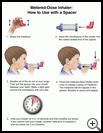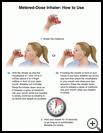
Metered-Dose Inhaler, How to Use
________________________________________________________________________
KEY POINTS
- A metered-dose inhaler is a hand-held device that sends a mist of medicine directly to your child’s lungs as your child takes a deep breath.
- There are several ways to use inhalers. Your healthcare provider or pharmacist can help you and your child learn how best to use the inhaler.
________________________________________________________________________
What is a metered-dose inhaler?
A metered-dose inhaler (MDI) is a hand-held device that releases a mist of medicine. Metered dose inhalers contain a harmless gas that helps the medicine get in to your child’s lungs. Inhalers help send the medicine directly to your child’s lungs as your child takes a deep breath.
A device called a spacer can be used with the inhaler. A spacer is a special bag or plastic tube that is attached to the inhaler. Spacers help when it is hard to press the inhaler at the same time that your child breathes in the medicine. The spacer holds medicine in the bag or tube and:
- Helps your child to breathe at your child’s own pace
- Helps more medicine to reach your child’s lungs
- Keeps medicine from just going in to the air
Spacers can be used with or without a mask. Some spacers are made for just one type of inhaler.
Several kinds of medicines are available as metered-dose inhalers, including:
- Rescue inhalers, also called reliever or quick relief medicines, act quickly to reduce symptoms. These medicines are used as needed to treat asthma attacks. They are one kind of bronchodilator. Bronchodilators are medicines that make breathing easier.
- Long-term control medicines, also called controller medicines. By taking this medicine regularly every day, it helps to control your child’s symptoms. They do not provide quick relief of wheezing in acute asthma attacks. These are also called bronchodilators.
- Steroid medicines, also called asthma controller medicines, because by taking them regularly every day, they help to control your child’s symptoms. They block some of the chemicals that cause irritation and swelling in your child’s body. By lessening the swelling, your child will have fewer symptoms and be able to breathe better.
When a child is using more than one type of inhaler, your child will usually use the rescue inhaler first.
How should my child use the inhaler?
There are several ways to use inhalers. Talk with your provider or pharmacist about this.
- Shake the inhaler well.
- If the inhaler has not been used before or if it has been more than two weeks since your child last used it, you must then “prime” the inhaler. Do this by spraying 2 or 3 sprays of the medicine in to the air. Each time your child uses the inhaler, the next dose is drawn in to a chamber inside the inhaler. If the inhaler has not been used or sits for a long time without being used, some of the medicine leaks out. This means your child will not get the full dose of medicine the next time it is used. Priming the inhaler makes sure that your child gets the full dose of the medicine.
- Hold the inhaler upright so the mouthpiece is at the bottom.
- Have your child breathe out fully.
- For many inhalers the best way to get the medicine in to the lungs is to hold the mouthpiece 1 to 2 inches (about 2 to 3 finger widths) in front of an open mouth. The best way to use some other types of inhalers is to place the inhaler mouthpiece directly in to your child’s mouth and have your child close his lips snugly around it. Use the inhaler as your healthcare provider instructs.
- Press the inhaler down once so it releases a spray of medicine while your child breathes in slowly and deeply. One spray is often called a puff. Have your child continue breathing in as slowly and deeply as possible.
- Have your child hold his or her breath and count slowly to 10. If your child cannot hold his or her breath this long, have your child hold it as long as is comfortable. This gives the medicine time to reach the lower airways.
- Have your child breathe out slowly.
If your child needs to take more than one puff, wait one minute before taking the next dose. Shake the medicine again and repeat steps 3 through 8 for another puff. Take the number of puffs prescribed by your healthcare provider.
If possible, have your child brush teeth and rinse his or her mouth with clear water after taking this medicine. The water your child rinses with should be spit out.
How do I clean the inhaler?
Wash the plastic case for the inhaler once a week with soapy tap water. Rinse well. Allow to air dry.
Do not store your child’s inhaler in places that may get hot or cold such as in a car.
Last modified: 2022-06-07
Last reviewed: 2022-05-12


